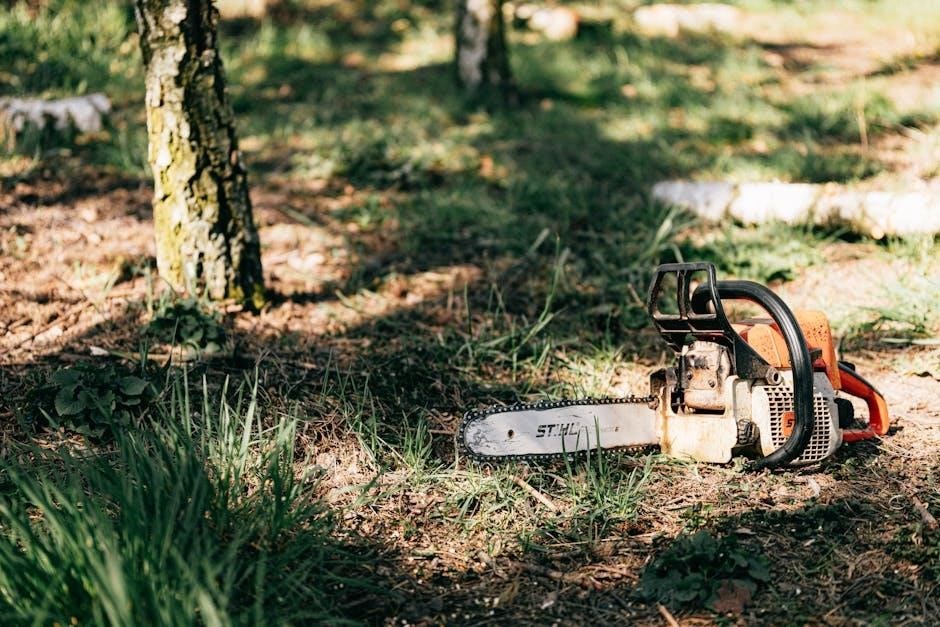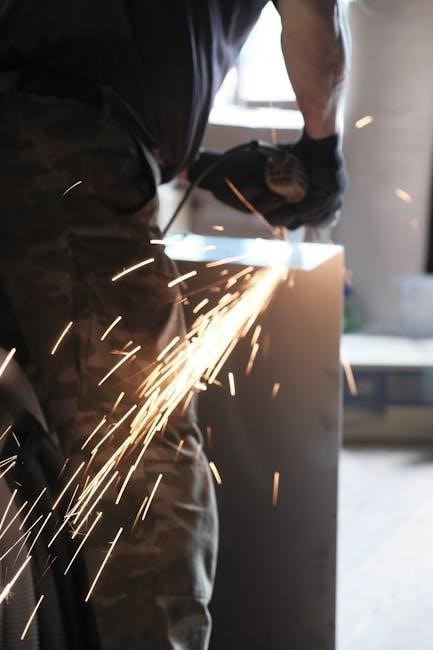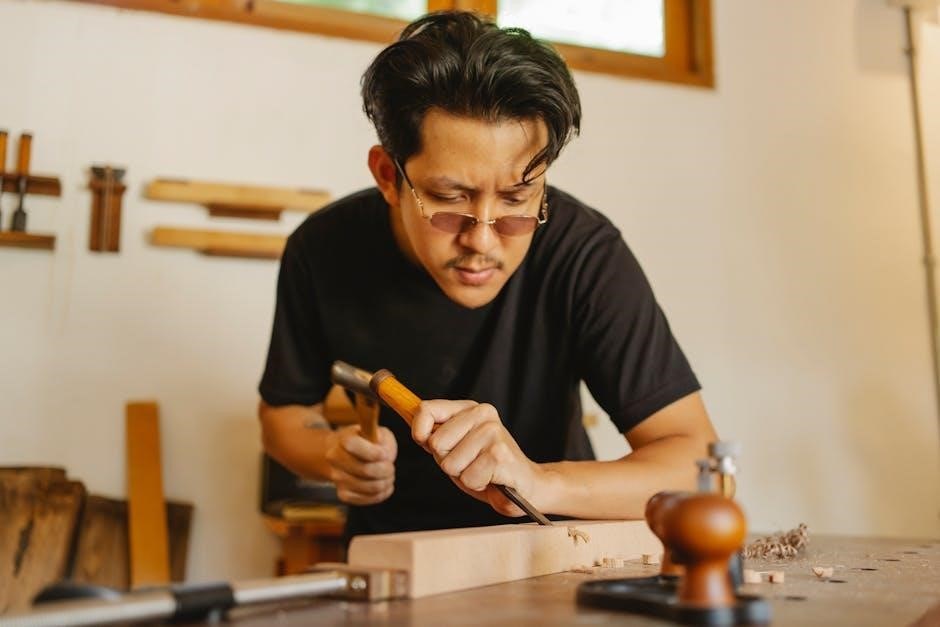Understanding the CUT 50 Plasma Cutter
The CUT 50 plasma cutter utilizes IGBT inverter technology. This technology transforms input power into a potent DC cutting current. This ensures efficient and reliable plasma cutting performance for various metalworking applications. It is ideal for portable and heavy-duty cutting.
Overview of CUT 50 Technology
The CUT 50 series employs advanced IGBT inverter technology. This enables the machine to efficiently convert input power into a stable and powerful DC output. This DC output is essential for creating the plasma arc. The plasma arc is used to melt and cut through various metals. This inverter-based design offers advantages such as improved energy efficiency‚ a lighter weight‚ and more precise control over the cutting parameters compared to traditional transformer-based plasma cutters‚ making it a versatile tool.
Key Features and Benefits
Key features of the CUT 50 plasma cutter include its portability and dual voltage capability. This allows operation on both 110V and 220V power sources. It provides versatility in various work environments. Its digital display provides precise control over amperage settings‚ ensuring accurate cuts. The machine’s efficient cooling system prevents overheating during extended use. This enhances durability. The CUT 50 offers a cost-effective solution for metal cutting needs with reliable performance.
Always disconnect the CUT 50 from power before maintenance. Ensure proper grounding to prevent electric shock. Inspect cables for damage before each use. Use appropriate personal protective equipment (PPE) at all times during operation.
Electrical Safety
Before initiating any work with the CUT 50 plasma cutter‚ meticulous attention must be given to electrical safety. Disconnect the machine from the power source prior to performing maintenance or adjustments. Verify the integrity of the power cables‚ ensuring they are free from damage. Employ grounding techniques to mitigate the risk of electric shock and always wear appropriate personal protective equipment.
Gas and Smoke Hazards
Plasma cutting produces fumes and gases that can be hazardous to your health. Always operate the CUT 50 in a well-ventilated area to prevent inhalation of harmful substances. Use a suitable respirator or ventilation system. Ensure proper exhaust to remove smoke and fumes away from the operator. Be aware of the specific gases produced when cutting different metals and their associated risks.
Safety Precautions
Fire Prevention
Plasma cutting generates sparks and molten metal‚ posing a significant fire risk. Clear the work area of all flammable materials before operating the CUT 50. Keep a fire extinguisher nearby and know how to use it. Be mindful of sparks traveling to adjacent areas. Use fire-resistant screens or blankets to contain sparks and protect surrounding objects. Inspect the area for smoldering materials after cutting.
The CUT 50 plasma cutter includes a torch‚ ground clamp‚ power switch‚ and gas input. Understanding each part ensures safe and effective use. Consult the manual for a detailed diagram of all components and their functions.
Identifying Key Parts
Essential components of the CUT 50 plasma cutter include the torch assembly for directing the plasma arc‚ a ground clamp ensuring proper electrical grounding‚ and a power switch for safe operation. The gas input connects to the air compressor‚ providing necessary gas flow. Internal components such as the inverter and control boards manage power conversion and operational control. Refer to the manual for detailed diagrams.
Main Components and Layout
Understanding the Control Panel
The control panel of the CUT 50 typically features a digital display. This provides real-time amperage readings and settings. An amperage adjustment knob allows precise control over the cutting power. Indicator lights signal power status‚ over-temperature conditions‚ and air pressure levels. Some models include a post-flow gas adjustment for optimal cutting results. Consult the CUT 50 manual for the specific layout and functions.
Before operating the CUT 50‚ connect the air hose to a suitable air compressor. Securely attach the ground clamp to the workpiece. Connect the plasma torch to the machine‚ ensuring a firm and proper fit.
Initial Setup and Connections
Prior to initiating the cutting process with the CUT 50‚ ensure the air hose is securely connected to a suitable air compressor‚ maintaining the pressure recommended in the manual. Firmly attach the ground clamp to the metal workpiece. Secure the plasma torch to the machine‚ ensuring it’s a proper fit. Connect the power cable to a grounded outlet‚ matching voltage requirements. Finally‚ review the manual’s safety precautions before proceeding with any cutting tasks.
Setting Amperage and Air Pressure
Consult your CUT 50 manual’s reference chart to determine appropriate amperage and air pressure. These settings depend on the metal type and thickness you intend to cut. Adjust the amperage knob on the control panel to the recommended value. Next‚ regulate the air compressor to achieve the plasma cutter’s specified air pressure‚ ensuring it is neither too high nor too low. Verify your selection. In this way‚ you can obtain the best cutting performance.

Operating Instructions
Cutting Techniques
Maintain a steady hand and consistent travel speed for clean‚ uniform cuts with your CUT 50. Start the arc by holding the torch tip slightly above the metal surface. Once the arc stabilizes‚ move the torch smoothly along the cutting path. Use a drag cutting technique for thinner materials‚ gently dragging the torch nozzle. For thicker metals‚ maintain a slight standoff distance. Always wear appropriate safety gear‚ including a welding helmet and gloves‚ to protect yourself from sparks and UV radiation during operation.
If the arc fails to start‚ inspect the electrode and nozzle for wear. Ensure proper air pressure and gas flow. Check the work clamp connection for good contact. A faulty start could indicate internal issues needing professional attention.
Arc Starting Problems
When facing issues with arc initiation on your CUT 50‚ several factors may be at play. Begin by meticulously examining the condition of both the electrode and nozzle‚ ensuring they are free from excessive wear or damage. Confirm that the air pressure and gas flow are precisely set according to the manufacturer’s specifications outlined in the manual. Additionally‚ verify the integrity and secure connection of the work clamp‚ ensuring optimal electrical conductivity for a stable arc.
Inconsistent Cuts
Inconsistent cuts with the CUT 50 plasma cutter can be attributed to several factors. First‚ ensure a steady hand and consistent travel speed during cutting. Variations in speed can lead to uneven results. Secondly‚ verify that the amperage setting aligns with the material thickness. Insufficient amperage may result in incomplete or ragged cuts. Lastly‚ inspect the work clamp connection. A loose clamp can disrupt the electrical circuit causing instability;

Troubleshooting Common Issues
Overheating
Overheating in a CUT 50 plasma cutter can stem from extended use at high amperage settings. Ensure the machine’s duty cycle isn’t exceeded. This will prevent thermal overload. Check for adequate ventilation around the unit. Obstructed airflow can hinder cooling‚ leading to overheating. Verify the air compressor is delivering consistent‚ clean‚ and dry air. Moisture or inadequate air supply can strain the system and cause overheating‚ potentially damaging internal components over time.
Regular cleaning and inspection are crucial for the longevity of your CUT 50. Ensure the machine is disconnected from power. Inspect the torch‚ cables‚ and connections for damage. Clean the unit and torch with a dry cloth.
Cleaning and Inspection
To maintain optimal performance of your CUT 50 plasma cutter‚ regular cleaning and thorough inspections are essential. Always disconnect the unit from the power source before commencing any maintenance procedures. Carefully inspect the torch‚ hoses‚ and all electrical connections for any signs of wear‚ damage‚ or loose fittings. Use a clean‚ dry cloth to wipe down the exterior of the machine and torch‚ removing dust‚ debris‚ and any accumulated grime. A clean machine ensures efficient operation and extends its lifespan.
Maintenance and Care
Replacing Consumables
The CUT 50 plasma cutter relies on several consumable parts. These parts need periodic replacement to maintain cutting efficiency. Key consumables include the electrode‚ nozzle‚ swirl ring‚ and retaining cap. Regularly inspect these components for wear‚ erosion‚ or damage. Replace them as soon as wear is apparent. Using worn consumables can lead to poor cut quality‚ arc instability‚ and potential damage to the torch. Always use manufacturer-recommended or equivalent replacement parts to ensure compatibility and optimal performance from your plasma cutter.
Various torch nozzles are available to enhance the CUT 50. These nozzles can optimize performance for specific cutting tasks. They can improve precision or cutting speed. Selecting the right nozzle improves the plasma cutter’s versatility.
Different Torch Nozzles
Different torch nozzles for the CUT 50 plasma cutter cater to specific cutting needs‚ influencing the precision‚ speed‚ and type of cut achievable. Fine cutting nozzles enhance accuracy for intricate designs‚ while high-speed nozzles prioritize rapid material removal. Extended nozzles provide greater reach in confined spaces. Heavy-duty nozzles withstand prolonged use and thicker materials. Selecting the appropriate nozzle maximizes efficiency and cut quality for the intended application.
Accessories and Optional Equipment
Air Compressors and Filters
Air compressors are essential for the CUT 50 plasma cutter‚ providing the necessary air supply for plasma generation. Choosing the right compressor involves considering the required CFM and pressure. Air filters are equally important‚ removing moisture and contaminants to ensure clean‚ dry air. This prevents damage to the plasma cutter and ensures consistent‚ high-quality cuts. Regular maintenance of both the compressor and filters is crucial for optimal performance and longevity.
The CUT 50D represents a specific model variation. It builds upon the standard CUT 50 plasma cutter. Differences may include enhanced features. These could be a digital display or improved performance. These changes cater to more demanding cutting tasks.
CUT 50D vs CUT 50
Distinguishing the CUT 50D from the base CUT 50 model involves considering several factors. The CUT 50D often incorporates digital displays for precise amperage control‚ enhancing usability. Performance enhancements might include improved arc stability or increased cutting speed. These upgrades make the CUT 50D suitable for users seeking greater precision. It is also suitable for efficiency in their plasma cutting applications. Ultimately‚ assess specific needs to determine the best choice.

CUT 50D Model Variations
Specific Features of CUT 50DP and CUT 50Pi
Exploring the CUT 50DP and CUT 50Pi models reveals distinctive features catering to specialized needs. The CUT 50DP may include a pilot arc function‚ improving arc starting on dirty or painted surfaces. Meanwhile‚ the CUT 50Pi might offer enhanced compatibility with CNC systems. These models provide added versatility for users with specific requirements‚ and improve cutting capabilities across different materials. It also helps enhance overall operational efficiency. Evaluate project demands to determine the ideal model.
Comparing the CUT 50 with models like the CUT 30 and CUT 70 highlights key differences; The CUT 30 offers less power‚ while the CUT 70 provides increased cutting capacity. Each model caters to distinct project scales and metal thicknesses.
CUT 30‚ CUT 70 Comparisons
When considering plasma cutters‚ the CUT 30‚ CUT 50‚ and CUT 70 models offer varying capabilities to suit different needs. The CUT 30 is ideal for lighter tasks‚ while the CUT 70 handles thicker materials. The CUT 50 provides a balance between power and portability. ESAB’s Cutmaster series also presents options‚ with models like the Cutmaster 30‚ 50‚ and 70 catering to diverse cutting requirements. Selecting the right model depends on the specific application and material thickness.

Comparison with Other Plasma Cutters
Advantages and Disadvantages
The CUT 50 plasma cutter presents several advantages‚ including its portability and efficient cutting capabilities. However‚ it also has disadvantages. It may struggle with exceptionally thick materials compared to higher-powered models. Its reliance on a clean‚ dry air supply is crucial‚ as moisture can negatively impact performance. Maintenance‚ such as replacing consumables‚ is essential. Considering these pros and cons helps determine if the CUT 50 aligns with specific project requirements. Its dual voltage is a plus.
The CUT 50 plasma cutter proves useful in metal fabrication. It offers precise cutting for various projects. These projects range from creating custom metal parts to assembling structures. Its efficiency enhances fabrication processes. It is suited for different metal types.
Metal Fabrication
In metal fabrication‚ the CUT 50 excels at creating precise cuts on various metal types. Its efficiency allows for the rapid creation of custom metal parts‚ essential for diverse fabrication projects. From constructing intricate metal structures to crafting specialized components‚ the CUT 50 offers the power and precision required. This makes it an invaluable tool for metalworkers needing reliable and accurate cutting capabilities in their fabrication processes‚ thus enhancing overall project quality.
Automotive Repair
The CUT 50 plasma cutter is highly valuable in automotive repair for its ability to quickly and accurately cut through vehicle components. It allows technicians to efficiently remove damaged sections of auto bodies. It also allows technicians to prepare areas for welding or replacement. The CUT 50’s precision ensures clean cuts. This is vital for seamless repairs and modifications. Thus‚ this makes it an indispensable tool in any auto repair shop for restoration and maintenance.
Applications of the CUT 50 Plasma Cutter
DIY Projects
For DIY enthusiasts and hobbyists‚ the CUT 50 plasma cutter opens up a world of creative possibilities. It’s perfect for crafting custom metal art‚ fabricating parts for home improvement projects‚ and repairing household items. Its ease of use and portability make it accessible for beginners. It also makes it a valuable tool for experienced makers. The CUT 50 allows for precise cutting of various metals. It empowers users to bring their creative visions to life with professional-quality results.
CNC Integration
Available Manuals and Resources
Where to Find the Official Manual
Official manuals for the CUT 50 plasma cutter are often available from the manufacturer’s website. They can also be found on online retailers’ product pages. These manuals provide essential safety guidelines‚ operating instructions‚ and troubleshooting tips for optimal use.
